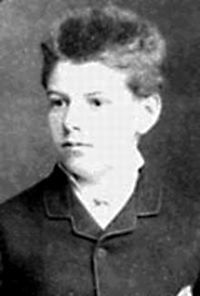Louis Bachelier facts for kids
Quick facts for kids
Louis Bachelier
|
|
|---|---|
 |
|
| Born | 11 March 1870 Le Havre, France
|
| Died | 28 April 1946 (aged 76) Saint-Servan-sur-Mer, France
|
| Nationality | French |
| Alma mater | University of Paris |
| Known for | Pioneer in mathematical finance |
| Scientific career | |
| Fields | Mathematics |
| Institutions | University of Paris Université de Franche-Comté (Besançon) Université de Dijon University of Rennes |
| Thesis | Théorie de la spéculation (The Theory of Speculation) (1900) |
| Doctoral advisor | Henri Poincaré |
Louis Bachelier (born March 11, 1870 – died April 28, 1946) was a French mathematician. He lived at the start of the 20th century. He is famous for being the first person to describe something called a stochastic process. This is a way to model things that change randomly over time. He used it to describe what we now call Brownian motion. He did this in his important school paper, called a doctoral thesis, in 1900. Its title was The Theory of Speculation.
Bachelier's paper was the first to use advanced math to study finance. Finance is about how money is managed, especially in markets. His work showed how to value stock options. These are like special contracts that give you the right to buy or sell stocks later. His ideas, known as the Bachelier model, helped create other important models. One famous model is the Black-Scholes model, which is still used today.
Because of his groundbreaking work, Louis Bachelier is seen as the founder of mathematical finance. He was also a pioneer in understanding how random events unfold over time.
Contents
Early Life and Challenges
Louis Bachelier was born in a city called Le Havre in France. His father was a wine merchant. He was also an amateur scientist and a diplomat for Venezuela. Louis's mother came from a family of important bankers.
Sadly, both of Louis's parents passed away soon after he finished high school. This meant he had to take care of his younger sister and brother. He also had to manage the family business. This put his plans for college on hold. During this time, he learned a lot about how financial markets work in real life. His studies were delayed even more because he had to serve in the military.
In 1892, Bachelier finally arrived in Paris to study at the Sorbonne. His grades there were not always the best.
His Important Doctoral Thesis
Bachelier presented his doctoral thesis on March 29, 1900, at the University of Paris. At first, many mathematicians did not fully understand or appreciate his work. This was because he was trying to use math in a new area: the world of money and markets. This was very unusual for mathematicians at the time.
However, his teacher, Henri Poincaré, gave him some good feedback. Poincaré was a very famous mathematician. He called Bachelier's ideas "very original." Even so, Bachelier did not immediately get a teaching job in France.
very original, and all the more interesting in that Fourier's reasoning can be extended with a few changes to the theory of errors. ... It is regrettable that M. Bachelier did not develop this part of his thesis further.
His thesis received a grade of honorable. This was a good grade, especially since his topic was so new. Experts today say that honorable was the highest grade possible for a paper that was so different from traditional math. It also had some parts that were not perfectly strict in their math.
A Career in Academia
After his thesis, Bachelier continued to develop his ideas. He worked on what are called diffusion processes. These describe how things spread out randomly over time. His work was published in important science magazines. In 1909, he became a "free professor" at the Sorbonne. This meant he could teach there without a permanent position.
In 1914, he wrote a book called Le Jeu, la Chance, et le Hasard. This means "Games, Chance, and Randomness." It was very popular and sold many copies. The University of Paris wanted to give him a permanent job. But then World War I started, and he had to join the French army. He served until the end of 1918.
After the war, in 1919, he found a job as an assistant professor in Besançon. He got married in 1920, but his wife passed away soon after. He moved to different universities, including Dijon and Rennes. Finally, in 1927, he got a permanent professorship at the University of Besançon. He worked there for ten years until he retired.
Bachelier's work on random walks came out five years before Albert Einstein's famous study of Brownian motion. A random walk is like taking steps in random directions. But for many years, people did not fully recognize how important Bachelier's work was. Later, other famous mathematicians like Andrey Kolmogorov and Paul Lévy noticed his ideas. Then, Leonard Jimmie Savage translated Bachelier's thesis into English. This helped Paul Samuelson and others learn about his work.
Bachelier's ideas also came before the efficient-market hypothesis. This idea suggests that stock prices already reflect all available information. This means future price changes are random, like a random walk. His work is now seen as a key foundation for the Black–Scholes model, which is very important in finance.
See also
 In Spanish: Louis Bachelier para niños
In Spanish: Louis Bachelier para niños
- Black–Scholes equation
- Bachelier model
- Martingale
- Random walk
- Brownian Motion
- Louis Bachelier Prize
- Henri Poincaré
- Vinzenz Bronzin
- Jules Regnault
Images for kids


